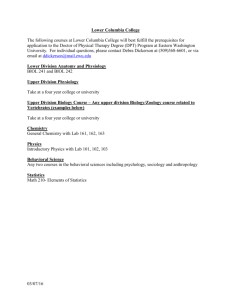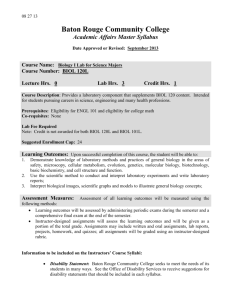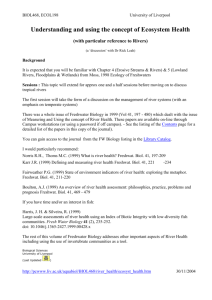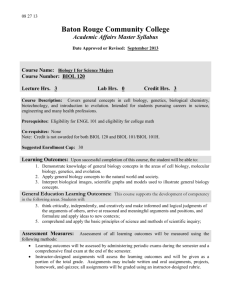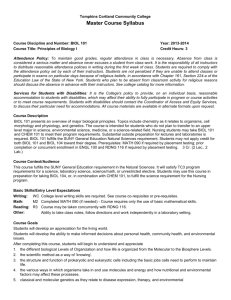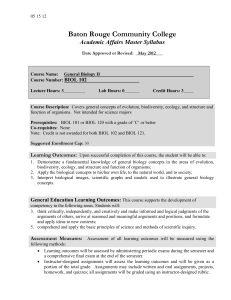Department: BIOL Course No: 108 Credits: 4 Title: Principles of
advertisement
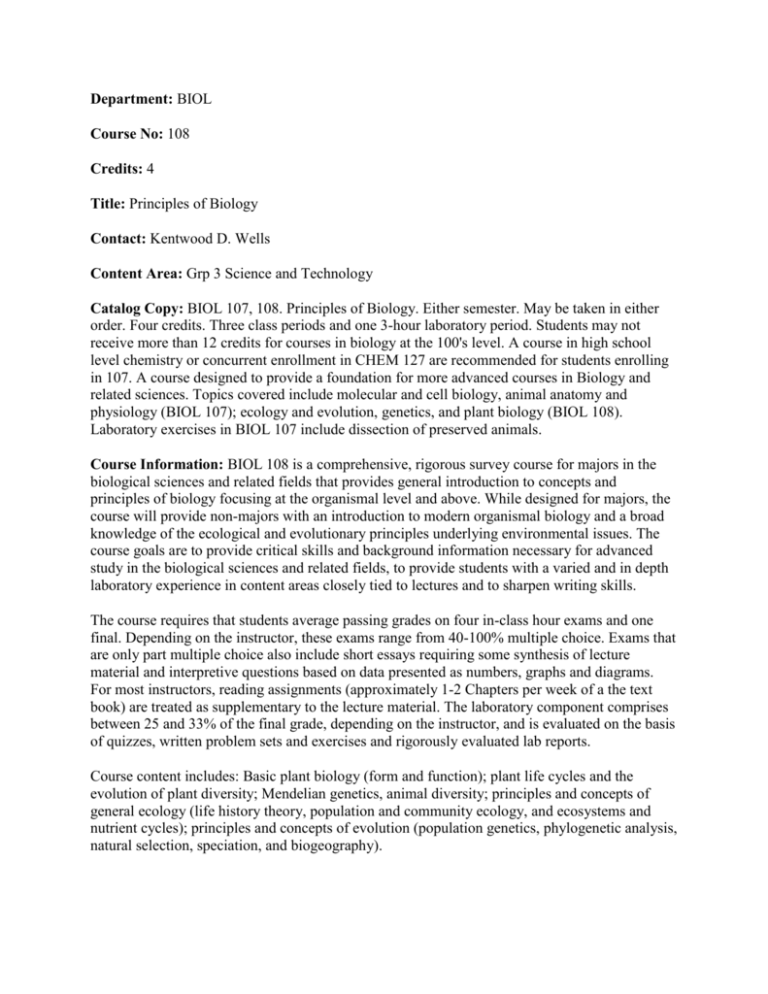
Department: BIOL Course No: 108 Credits: 4 Title: Principles of Biology Contact: Kentwood D. Wells Content Area: Grp 3 Science and Technology Catalog Copy: BIOL 107, 108. Principles of Biology. Either semester. May be taken in either order. Four credits. Three class periods and one 3-hour laboratory period. Students may not receive more than 12 credits for courses in biology at the 100's level. A course in high school level chemistry or concurrent enrollment in CHEM 127 are recommended for students enrolling in 107. A course designed to provide a foundation for more advanced courses in Biology and related sciences. Topics covered include molecular and cell biology, animal anatomy and physiology (BIOL 107); ecology and evolution, genetics, and plant biology (BIOL 108). Laboratory exercises in BIOL 107 include dissection of preserved animals. Course Information: BIOL 108 is a comprehensive, rigorous survey course for majors in the biological sciences and related fields that provides general introduction to concepts and principles of biology focusing at the organismal level and above. While designed for majors, the course will provide non-majors with an introduction to modern organismal biology and a broad knowledge of the ecological and evolutionary principles underlying environmental issues. The course goals are to provide critical skills and background information necessary for advanced study in the biological sciences and related fields, to provide students with a varied and in depth laboratory experience in content areas closely tied to lectures and to sharpen writing skills. The course requires that students average passing grades on four in-class hour exams and one final. Depending on the instructor, these exams range from 40-100% multiple choice. Exams that are only part multiple choice also include short essays requiring some synthesis of lecture material and interpretive questions based on data presented as numbers, graphs and diagrams. For most instructors, reading assignments (approximately 1-2 Chapters per week of a the text book) are treated as supplementary to the lecture material. The laboratory component comprises between 25 and 33% of the final grade, depending on the instructor, and is evaluated on the basis of quizzes, written problem sets and exercises and rigorously evaluated lab reports. Course content includes: Basic plant biology (form and function); plant life cycles and the evolution of plant diversity; Mendelian genetics, animal diversity; principles and concepts of general ecology (life history theory, population and community ecology, and ecosystems and nutrient cycles); principles and concepts of evolution (population genetics, phylogenetic analysis, natural selection, speciation, and biogeography). Meets Goals of Gen Ed: BIOL 108 is proposed as a course to be included in the Science and Technology Content Area. Goal 2. Intellectual breadth and versatility. In an era of increasing specialization in the sciences and heavy reliance on technology, most students entering college are poorly prepared in organismal biology and in how organisms interact at multiple levels in the natural world. BIOL 108 provides the foundations of the biotic context for all life on earth as well as an introduction into how biological science at larger scales is conducted. For many pre-professional students, Biol 108 will be their only experience with the science underlying the ecological and environmental issues they will confront in a world of diminishing natural resources. Goal 7. Acquire a working understanding of the processes by which they can continue to acquire and use knowledge. Fundamentally, the facts taught in BIOL 108 are borne of the scientific processes of hypothesis testing, deductive reasoning, and rigorous interpretation of results. We teach by example that science is a process, that is, we present the data and observations underlying material we present as facts. We challenge students to present arguments or observations that would question accepted facts. In the laboratory portion of the course, students experience the process of science by conducting laboratory experiments, analyzing and interpreting the results, and presenting the results as a written communication in the form of a lab report. CA3 Criteria: 1. Explore an area of science by introducing students to a broad, coherent body of knowledge. As we confront the expanding impacts of our presence on earth, we as individuals will be forced to make ever more difficult choices about the allocation of natural resources. A broad understanding of all aspects of biology, from molecules through ecosystems, is the first step toward informed decisions. BIOL 108 provides the core biological concepts and principles needed to understand ecological and evolutionary consequences of biotic interactions. BIOL 108 emphasizes the both the current roles of organisms on their environments and the evolutionary principles underlying these roles. Understanding the biology of plants is prerequisite to teaching the importance of their role as the primary source of energy on earth. Mendelian and population genetics explain the transmission of traits through time and space. 2. The nature of modern scientific inquiry and the process of investigation. BIOL 108 has two main componets. One is the lecture, where the facts and concepts of biology are provided. In as much as time allows, presenting the stories the behind discoveries teach the process of science by example, especially when reasoning behind hypotheses and subsequent interpretations of experiments are profiled. Also, students are challenged on exams to practice various elements of the scientific process, for example, to provide explanations for presented facts or data, to synthesize information from several lectures, or to interpret observations or data new to them. The second component of BIOL 108 is the lab where all students gain first-hand experience in designing experiments, proposing testable hypotheses, analyzing data they have collected, and interpreting the results within their knowledge base and then communicating these results in the form of a written report. 3. Students are faced with unresolved questions in biology every time they ask a question and the instructor responds that “we,” meaning “no one,” really knows the answer to that question yet. Most instructors automatically respond with what they do know that is relevant to the answer, and what would need to be known in order to answer the question. The students become part of the process of science by virtue of being present in the lecture and thus in a position to ask the question. In addition, many instructors incorporate discussions of what “we” don't know yet, or what has just been discovered into their lectures. 4. Interest, competence and commitment to continued learning are promoted first and foremost by instructors who are personable, respectful of students and passionate about their subject matter. Clearly presented material that challenges students to engage on the spot helps promote these traits in students. Highlighting the unanswered questions in the field also helps, as does practical, real-life application of concepts. BIOL 108 is staffed primarily by dynamic, experienced professors who love what they do. CA3 Lab Criteria: Each lab requires three hours in class per week. The sequence of labs, and occasionally the content are varied depending on the instructors. Weeks 1-2. Plant structure and development; introduction to using Excel. Students prepare fresh sections and use commercially prepared slides to study the internal structure of flowering plants (i.e. leaf, stem and root anatomy). Students learn to use Excel by following a guided lab exercise. Students complete drawings while in lab and take a quizes the following weeks. Weeks 3-4. Experiments in Plant Physiology; Writing lab reports. In Week 3, students set up experiments to study plant transpiration (water loss) under different environmental conditions. In week 4, students extract photosynthetic pigments from bean plants and calculate the chlorophyll concentrations. Students use Excel to graph their data and must present the results in a detailed lab report the following week. Students are carefully instructed in how to write detailed lab reports using correct formats for scientific citations. Weeks 5-6. Plant diversity. Plant Competition. In Week 5, A four-week experiment on plant competition is initiated. In weeks 5 and 6, students analyze reproductive and vegetative structures of major plant groups (mosses, ferns, gymnosperms and angiosperms) to understand plant diversity. The following weeks students identify structures and describe their significance in a quiz. Weeks 7-8. Mendelian and Population Genetics. In Week 7, students collect data on a series of genetic crosses designed to illustrate basic tenets of Mendelian genetics. In Week 8, they use a model of a gene pool (colored beads) to illustrate fundamental principles in population genetics. They are expected to complete a series of exercises in the lab manual to analyze their results. Students turn in a problem set on Mendelian genetics completed outside of lab time the following week. Week 9. Plant Competition. Students collect data and are guided through a series of calculations that allow them to determine the relative intensity of intra- and interspecific competition. Students use their data to produce a detailed lab report due two weeks later. Week 10. Animal Behavior. Students design and conduct a series of behavioral experiments on live animals ( non-social behaviors in crickets; aggressive behaviors in fish). Students must complete a set of questions on lab outside of class. Weeks 11 and 12. Animal Diversity. Students study animal body plans and character diversity using specimens displayed around the lab. The first week focuses on invertebrates and the second week on vertebrates. Students complete charts of characters that they use to analyze the major evolutionary changes in the animal body plan. Students must turn in their cladograms for evaluation and must take quizzes on the material the weeks following the labs. Week 13. Field Ecology. Students are guided through a series of ecological sampling techniques using the freshwater ponds on campus. Role of Grad Students: Graduate student TA's teach all laboratory sections, with two TA's per section. Supervision is by a laboratory coordinator and instructors in the course. All TA's are required to attend weekly meetings in which all aspects of the upcoming labs are discussed by the coordinator and instructors. New TA's are required to attend teaching workshops offered to all incoming teaching assistants in the university.


